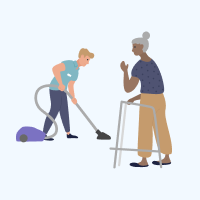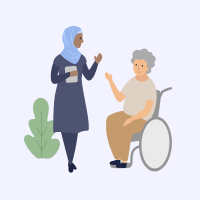On 1 July 2014, the way fees are worked out for Home Care Packages and aged care homes changed. These changes are part of reforms to make the aged care system more sustainable and affordable.
If you received a Home Care Package or moved into an aged care home before 1 July 2014, the new fee arrangements that started on 1 July 2014 do not apply to you. You will keep paying the fees that you already pay.
Aged care home costs
Moving aged care homes
Home Care Package costs
Moving to a new home care provider
Aged care home costs
If you moved into an aged care home before 1 July 2014, you will keep paying the fees that you already pay.
Basic daily fee
Everyone who lives in an aged care home can be asked to pay the basic daily fee – also called a standard resident contribution. This fee helps cover the costs of daily living, like meals, cleaning, laundry, heating and cooling.
For pre-1 July 2014 residents, the fee is one of the following:
- standard resident contribution. This is 85% of the single basic age pension. The amount changes with the age pension amount every March and September.
non-standard resident contribution, if you first entered residential aged care before 20 March 2008.
On 19 September 2009, and on each day since then, you must not have a dependent child and must meet one of the following criteria:- not be getting an income support payment
- have paid an accommodation bond that is more than 10 times the basic age pension amount at the time of entry into care
- have not provided income and asset information to Services Australia
If you no longer meet the criteria on or after 20 September 2009, you will pay the standard resident contribution.
protected resident contribution, if you were in care on 19 September 2009, and on that day:
- were a self-funded retiree or part pensioner
- your private income was equal to or more than the threshold amount for protected residents.
The basic daily fee is set at the protected resident contribution rate in the Schedule of Fees and Charges for Pre-1 July 2014 Residential and Home Care Recipients.
Income tested fee
If your income is above the income threshold when Services Australia or DVA assesses you, your provider can ask you to pay an income tested fee. This fee is different for everyone because it’s based on your income and the cost of your care.
The income tested fee that you pay will be between $0 to $101.37 per day.
The fee is equal to the income tested amount or the cost of your care – whichever is lower. Services Australia calculates and advises the income tested amount.
Your income tested fee can change while in care, but there’s a maximum that you could be charged per day. This maximum changes over time.
For more information on basic daily fees, income tested fees, and rates and charges that apply to residents, read the Schedule of Fees and Charges for Pre-1 July 2014 Residential and Home Care Recipients.
Accommodation costs
There are two types of accommodation costs: accommodation charges and accommodation bonds.
An accommodation charge may have been applied if:
- you moved into an aged care home and had high-level care needs (other than an extra-service place).
An accommodation bond may have been applied if:
- you moved into an aged care home and had low-level care needs, or
- you moved into an extra-service place with high-level care needs.
If you move to a new home and remain under the pre-1 July 2014 fee arrangements:
- you will pay a bond in your new home if you were paying a bond in your old home
- you will pay a charge in your new home if you were paying a charge in your old home.
Read more about accommodation charges and accommodation bonds if you entered care before 1 July 2014.
Extra service fees
Some aged care homes have "extra service" status. This status can apply to the whole home or just to individual rooms. Extra services are hotel-type services, such as better accommodation and food.
Aged care homes with this status can charge extra service fees. If you entered an extra service room when you moved into the aged care home, you have to pay these fees.
Extra service fees are not subsidised by the government; you have to pay the full cost. These fees should have been agreed to and set out in your extra service agreement before you moved into the home.
Additional service fees
Many aged care homes offer additional hotel-type services such as a preferred brand of toiletries, access to paid TV services, or arranging a hairdresser. These services have to be paid for through additional service fees.
Some homes allow you to pick and choose what additional services you would like, so you only pay for what you use. Others may have a package of additional services they provide.
Your home will be able to provide you with information on the additional services they provide, their associated costs, and whether they are mandatory services that come with living at the home. You will only be charged for additional services that you can make use of or benefit from.
Financial hardship
If you cannot pay your aged care home costs, you can ask for financial hardship assistance through Services Australia.
You can apply for financial hardship assistance for your basic daily fee, income tested fee, accommodation charge, and accommodation bond.
More information
A full list of current rates and charges that apply to residents is available in the Schedule of Fees and Charges for Pre-1 July 2014 Residential and Home Care Recipients.
Moving aged care homes
If you move to another aged care home after 1 July 2014, you can keep your current fee arrangement, or opt in to the new fee arrangements (after 1 July 2014).
Keeping your current fee arrangement
You can only choose to keep your current fee arrangements if you have not had a break of more than 28 days between living at either aged care home. If you have left care for more than 28 days, your fees will automatically be calculated using the fee arrangements that were introduced on 1 July 2014.
Opting in to the new fee arrangements (after 1 July 2014)
To opt in, you need to complete the Continuing Care Recipient opting into the New Aged Care Arrangements from 1 July 2014 (AC022) form and have your provider submit it to Services Australia before you transfer.
If you do not submit this form before you transfer, you will automatically keep your current fee arrangements. Once this is done, it cannot be changed. You should discuss opting in with your new aged care provider beforehand.
Your provider will also need to give you to read New Arrangements for Aged Care from 1 July 2014 – Residential Care.
Read more about the post-1 July 2014 fee arrangements on the aged care homes costs and fees page.
Home Care Package costs
If you received a Home Care Package before 1 July 2014, you will keep paying the fees that you already pay.
Basic daily fee
Everyone who receives a Home Care Package can be asked to pay a basic daily fee. This fee varies depending on your Home Care Package level.
The basic daily fee is set by the government at a percentage of the single basic age pension. The maximum basic daily fee increases in March and September each year in line with the age pension.
From 20 March 2025, the basic daily fee by Home Care Package level is:
| Package level | Basic daily fee |
|---|---|
| Level 1 | $11.77 |
| Level 2 | $12.45 |
| Level 3 | $12.80 |
| Level 4 | $13.14 |
Income tested fee
Your income tested fee is set by your home care provider. If you earn more than the single age pension, your service provider can ask you to pay an income tested fee. This fee can be up to 50% of the difference between your income and the single age pension.
Your income tested fee is calculated using your net income, which is your income after income tax and the Medicare levy.
However, the following exclusions are made when calculating your income tested fee:
- the pharmaceutical allowance, rent assistance, or telephone allowance
- the pension supplement
- the energy supplement
- if you receive a pension under the Veterans’ Entitlements Act 1986 (except a Service Pension) — an amount equal to 4% of the pension.
Additional fees
Any other amount you have agreed to pay for additional care and services that wouldn’t otherwise be covered by your Home Care Package.
Financial hardship
Your fees are set by your home care provider. They set the fees by considering your income and unavoidable expenses such as:
- high pharmaceutical bills
- rent
- utilities
- other living expenses
If you are experiencing financial hardship, you can negotiate a lower basic daily fee and/or income tested fee directly with your provider.
More information
A full list of current rates and charges that apply to home care recipients is available in the Schedule of Fees and Charges for Pre-1 July 2014 Residential and Home Care Recipients.
Moving to a new home care provider
If you move to another home care provider after 1 July 2014, you can keep your current fee arrangement, or opt in to the new fee arrangements (after 1 July 2014).
To opt in, you need to complete the Continuing Care Recipient opting into the New Aged Care Arrangements from 1 July 2014 (AC022) form and have your provider submit it to Services Australia before you transfer.
If you do not complete and submit this form before you transfer, you will automatically keep your pre-1 July 2014 fee arrangements. Once this is done, it cannot be changed. You should discuss opting in with your new aged care provider beforehand.
Your provider will also need to give you to read New Arrangements for Aged Care from 1 July 2014 – Home Care.
To learn more about fee arrangements that started on 1 July 2014, get detailed information on these pages:


